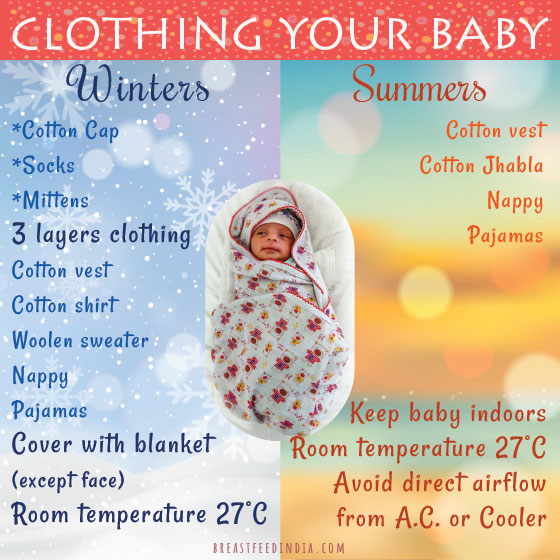How To Dress Your Baby According To Season
Comfortable clothing is vital to your baby's health because babies cannot tolerate heat or cold like us. Here's why proper clothing is essential for your baby:
Babies are at a very high risk of getting too cold (hypothermic)
- The skin surface area to weight ratio of newborn babies is 3-4 times higher compared to adults. This means they lose heat very fast.
- Babies are less capable of making body heat. When we feel cold, we make body heat by shivering. But babies cannot shiver.
- Babies lose body heat just after birth. Doctors take special care to reduce the heat loss of a baby after birth – proper clothing plays an important role.
- Preterm and sick babies have a higher risk of losing body heat.
- Keep room temperature around 26-28°C in winters – neither too cold nor too hot.
- Keep your baby dry.
Babies also struggle to regulate body temperature in summers
- Babies have immature kidneys that cannot concentrate urine efficiently. That's why they have a higher risk of dehydration in summers.
- Avoid taking your baby outdoors during peak heat hours (10 AM - 4 PM) in summers. Exposure to direct sunlight can quickly cause dehydration in babies.
Babies can easily develop skin allergies and infections
- Buy cotton clothes for your baby – they do not cause skin allergies.
- For winters, two to three layers of cotton clothes can keep your baby warm and comfortable. You can put on a woolen sweater over cotton.
- Wet nappies can cause skin infections in the diaper area – dress in a way you can easily check and replace nappies. Always keep your baby's diaper area dry.

Protect From Cold While Dressing Your Baby In Winters
A general rule: If you are comfortable in two layers of clothes, your baby should wear three.
Dress your baby in layers of cotton clothes. Two or three layers of cotton clothes are much better than one sweater.
Winter dress:
- Cotton cap
- Mittens (hand gloves)
- Socks
- Cotton vest
- Full sleeves cotton shirt
- Woolen sweater (while outdoors)
- Nappy
- Pajamas
Cover your baby with a light blanket. Do not use a thick or fluffy blanket – these may block the baby's breathing.
Never cover your baby's face with a blanket or any cloth.
Cap, mittens, and socks are very important in winters.
Avoid Overclothing The Baby In Summers
During summers, dress your baby in loose cotton clothes.
Summer dress:
- Cotton vest
- Cotton jhabla
- Nappy
- Pajamas
Maintain a comfortable room temperature. Avoid exposing the baby to direct airflow from the air-conditioner or cooler.
Keep Baby's Clothes Ready At Birth
Parents-to-be are often so busy taking care of the pregnancy that they forget to get clothes before birth. And when the time comes, they have to run for clothes. Here's what you can do to avoid last-minute hassle:
- Buy at least 3-4 pairs of clothes for the baby.
- Get blankets, bedsheets, caps, socks, mittens, and nappies.
- Wash all new clothes and pack them in a clean bag.
- Once you have these ready, you'll be well-prepared to welcome your baby.
Keep checking your baby's temperature in winters. Touch your baby's palms and soles with the back of your hands – they should feel warm.
Check how to give kangaroo care to maintain the baby's temperature and tons of other benefits.
Learn how to check the temperature of your baby.
If you have any questions about dressing your baby, feel free to contact us. Wishing you a happy and safe parenthood!